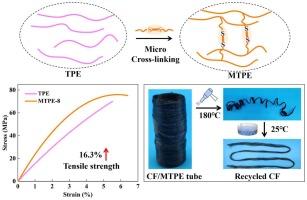Micro cross-linking strategy with dynamic covalent bond for high-performance epoxy-based thermoplastic polymer and polymer composites
IF 8.1
2区 材料科学
Q1 ENGINEERING, MANUFACTURING
Composites Part A: Applied Science and Manufacturing
Pub Date : 2025-09-26
DOI:10.1016/j.compositesa.2025.109324
引用次数: 0
Abstract
Developing high-performance thermoplastic polymer and polymer composites with convenient manufacturing and recycling performance still presents a challenge. Herein, a micro cross-linking strategy was introduced to balance the relationship between processability and mechanical properties of thermoplastic polymer. Though this strategy, a polyfunctional aromatic amine containing disulfide bond (AFD) was used as chain extender to prepare the micro cross-linking thermoplastic epoxy (MTPE). By controlling the AFD content, MTPE with various cross-linking densities were successfully synthesized. Compared with linear thermoplastic epoxy (TPE), the glass transition temperature and tensile strength of MTPE, and the tensile properties of carbon fiber reinforced MTPE composites (CF/MTPE) was significantly increased by 11.5 %, 16.3 % and 7.8 %, respectively. And, due to the dynamic exchange characteristics of disulfide bonds, the processing temperature of MTPE could be consistent with that of TPE. Additionally, full-length carbon fibers could be conveniently and rapidly recovered from CF/MTPE composites. Due to the excellent compatibility between MTPE and difunctional epoxides, the fine powder of CF/MTPE composites could be treated as a filler to enhance the mechanical properties of difunctional epoxides-based thermosets. This micro cross-linking strategy provides a new way for producing high-performance thermoplastic polymers and offers valuable insights into the recycling of composite materials.

高性能环氧基热塑性聚合物及聚合物复合材料的动态共价键微交联策略
开发制造方便、可循环利用的高性能热塑性聚合物和聚合物复合材料仍然是一个挑战。本文提出了一种微交联策略来平衡热塑性聚合物的可加工性和力学性能之间的关系。以含二硫键的多官能团芳香胺(AFD)为扩链剂,制备了微交联热塑性环氧树脂(MTPE)。通过控制AFD含量,成功合成了不同交联密度的MTPE。与线性热塑性环氧树脂(TPE)相比,MTPE的玻璃化转变温度和拉伸强度以及碳纤维增强MTPE复合材料(CF/MTPE)的拉伸性能分别显著提高11.5%、16.3%和7.8%。并且,由于二硫键的动态交换特性,MTPE的加工温度可以与TPE的加工温度一致。此外,从CF/MTPE复合材料中可以方便、快速地回收出全长碳纤维。由于MTPE与双官能团环氧化物之间的良好相容性,CF/MTPE复合材料的细粉可以作为填料来提高双官能团环氧化物基热固性材料的力学性能。这种微交联策略为生产高性能热塑性聚合物提供了一种新的途径,并为复合材料的回收利用提供了有价值的见解。
本文章由计算机程序翻译,如有差异,请以英文原文为准。
求助全文
约1分钟内获得全文
求助全文
来源期刊

Composites Part A: Applied Science and Manufacturing
工程技术-材料科学:复合
CiteScore
15.20
自引率
5.70%
发文量
492
审稿时长
30 days
期刊介绍:
Composites Part A: Applied Science and Manufacturing is a comprehensive journal that publishes original research papers, review articles, case studies, short communications, and letters covering various aspects of composite materials science and technology. This includes fibrous and particulate reinforcements in polymeric, metallic, and ceramic matrices, as well as 'natural' composites like wood and biological materials. The journal addresses topics such as properties, design, and manufacture of reinforcing fibers and particles, novel architectures and concepts, multifunctional composites, advancements in fabrication and processing, manufacturing science, process modeling, experimental mechanics, microstructural characterization, interfaces, prediction and measurement of mechanical, physical, and chemical behavior, and performance in service. Additionally, articles on economic and commercial aspects, design, and case studies are welcomed. All submissions undergo rigorous peer review to ensure they contribute significantly and innovatively, maintaining high standards for content and presentation. The editorial team aims to expedite the review process for prompt publication.
 求助内容:
求助内容: 应助结果提醒方式:
应助结果提醒方式:


